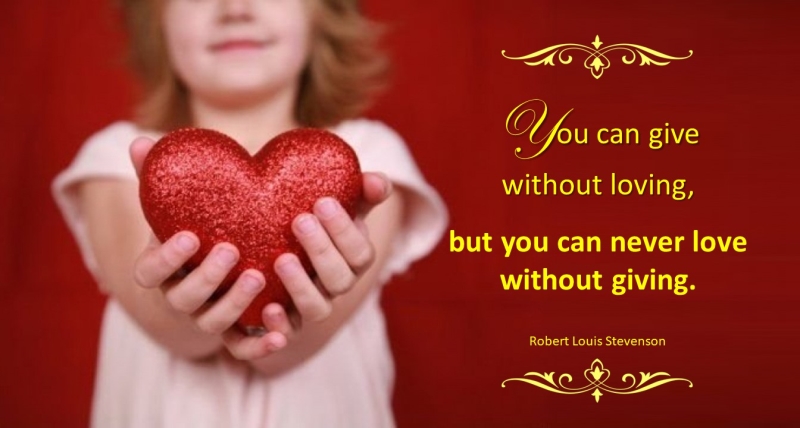WHEN WE THINK OF “LOVE,” WE OFTEN ASSOCIATE IT WITH WARMTH, HAPPINESS, AND KINDNESS. But have you ever considered the idea that love also involves giving? Whether it’s time, attention, or resources, giving is a crucial part of any relationship, and it’s something that can never be replaced. In this article, we’ll explore the concept of “giving in love” and why it’s so crucial to the health and longevity of any relationship.
Giving vs. receiving
Before we dive into the importance of giving in love, we must acknowledge the role of receiving. While sharing is essential to a healthy relationship, so is receiving. Receiving can be as important as giving, as it allows the person offering to feel appreciated and valued. Without a balance of giving and getting, a relationship can quickly become out of whack and unhealthy.
The power of giving
Giving can take many forms in a relationship, whether a simple act of kindness, a thoughtful gift, or a significant sacrifice. Some of the many ways that giving can make a romantic relationship stronger are:
- It fosters trust: When we give to someone, we show them that we trust them. Whether it’s our time, attention, or resources, we believe in their ability to appreciate and use what we give them.
- It creates connection: Giving is one of the most effective ways to connect with someone. Giving allows us to bond with another person through a shared experience or a thoughtful gift.
- It shows appreciation: When we give to someone, we show them that we appreciate them. This can be a powerful way to strengthen a relationship and make the other person feel valued and loved.
- It builds intimacy: Giving can also be a way to build intimacy in a relationship. When we give to someone, we allow ourselves to be vulnerable with them, which can deepen our emotional connection.
Giving without loving
Giving is an integral part of any healthy relationship, but it’s important to remember that you can give without loving. In fact, many of us have given to others without genuinely feeling a sense of love or connection. So, why is this the case?
For starters, giving can be a way to gain power or control over someone. For example, if we give someone a gift, we may expect something in return, whether it’s their attention or gratitude. This kind of giving is not driven by love but by a desire for something in return.
Additionally, giving can be a way to alleviate guilt or shame. For example, if we’ve hurt someone, we may provide them with a gift or offer to help make them feel better rather than out of a true sense of love or compassion.
Even though it is possible to give without love, it is essential to realize that this giving can’t last in a relationship. Eventually, the other person will sense that the giving is not coming from a real place, which can lead to resentment and distance.
Loving without giving
On the other hand, loving without giving is not possible. To love someone is to take action beyond just how you feel. It requires us to provide for ourselves, whether it’s our time, attention, or resources. Without giving, love is an abstract concept rather than a tangible force.
The importance of balance
So, if giving is vital to loving, should we always offer it to our partners, friends, and family? Not necessarily. Like any other aspect of a relationship, presenting requires balance. Consider the following to help you find a happy medium between giving and receiving in your relationships.
- Give without expectation: When we give with the expectation of receiving something in return, it’s not truly giving. Instead, try to give without expecting anything in return. This can help you feel more fulfilled and connected to the person you’re giving to.
- Communicate your needs: It’s essential to communicate your needs in a relationship, whether needing more attention, support, or understanding. This can help ensure that you’re giving and receiving balanced.
- Be mindful of your resources: It’s essential to be aware of your own resources when it comes to giving. This means taking stock of your time, energy, and money and ensuring you share only what you can afford.
- Practice gratitude: Finally, practicing gratitude in a relationship is essential. This means acknowledging and appreciating what your partner, friend, or family member does for you. This can help create a sense of balance and reciprocity in the relationship.
The psychology of giving and receiving
Research has shown that giving can be a powerful source of positive emotions like joy, satisfaction, and meaning. When we give to others, we activate the reward centers in our brains, which can lead to feelings of pleasure and happiness.
To better understand the role of giving and receiving in relationships, looking at the psychological underpinnings of these behaviors can be helpful.
At the same time, receiving can be a powerful source of positive emotions. We feel valued, appreciated, and cared for when we receive from others. Receiving can also help build trust and intimacy in a relationship, allowing us to let down our guard and be vulnerable with others.
But some psychological factors can make giving and getting hard, such as:
- Attachment styles: People with different attachment styles may have different attitudes toward giving and receiving. For example, those with anxious attachment styles may be more likely to give to win approval or avoid rejection. In contrast, those with avoidant attachment styles may be more hesitant to provide or receive out of fear of becoming too dependent.
- Expectations and reciprocity: When we give to others, we often expect reciprocity or acknowledgment in return. However, this can sometimes lead to disappointment or resentment if the other person doesn’t respond as we hoped. On the other hand, when we receive from others, we may feel indebted or obligated to give back, which can create a sense of pressure or anxiety.
- Power dynamics: Power dynamics in a relationship can also influence giving and receiving. For example, suppose one person is in a position of authority or has more resources than the other. In that case, they may be more likely to give, while others may feel uncomfortable receiving. Alternatively, one person is overly dependent on the other. In that case, they may feel pressure to give more than they are comfortable with.
The role of cultural and social factors
Cultural and social factors can also affect how we give and receive in relationships. For example, some cultures place a lot of value on reciprocity and duty. On the other hand, others may place a high value on self-sufficiency and independence. In addition, social norms around gender and power can also influence how we give and receive. For example, women may be expected to be more giving and nurturing. In contrast, men may be expected to be more self-sufficient and less emotionally expressive.
Examples of giving and loving in different types of relationships
While giving and loving is universal, how they are expressed can vary depending on the kind of relationship. Here are some examples:
- Romantic relationships: In romantic relationships, giving and receiving can take many forms, such as physical affection, emotional support, acts of service, or gifts. However, it’s important to remember that giving and receiving should be balanced and consensual. In healthy relationships, both partners should feel comfortable expressing their needs and boundaries and work together to find a balance that works for them.
- Friendships: Giving and receiving can also take many forms, such as emotional support, advice, or shared experiences. However, like romantic relationships, it’s vital to ensure that giving and receiving are balanced and consensual. Friends should feel comfortable expressing their needs and boundaries and work together to find a balance for both.
- Familial relationships: In family relationships, giving and receiving can be emotional support, financial support, or caregiving. However, familial relationships can also be complicated by issues of obligation and expectation. For example, adult children may feel pressure to give back to their parents for years of support. In contrast, parents may feel pressure to continue giving to their adult children even if it becomes unsustainable or unhealthy.
Balancing giving and self-care
While giving and loving can be powerful sources of happiness and fulfillment, it’s also important to remember the importance of self-care. Giving too much of ourselves can lead to burnout, resentment, or feelings of being taken advantage of. So, finding a balance between helping others and caring for our needs is crucial.
Here are some tips for finding this balance:
- Set boundaries: It’s essential to communicate your needs and limitations with others clearly and to say no when necessary. This can be especially important in relationships with a power imbalance or where you give more than you receive.
- Take care of your own needs: Make sure you are taking care of your physical and emotional needs, such as getting enough sleep, eating well, and engaging in activities that bring you joy and fulfillment.
- Practice self-compassion: Remember that it’s okay to make mistakes or to need help from others. Self-compassion entails being gentle and forgiving to oneself.
- Seek support: Be bold and seek support from others when needed. Whether from a friend, family member, or therapist, reaching out for help can be an essential form of self-care.
Conclusion
In conclusion, giving is a crucial part of any healthy relationship. Whether it’s a small act of kindness or a significant sacrifice, giving allows us to foster trust, create connection, show appreciation, and build intimacy with the people we love. While giving without loving is possible, it’s not sustainable in the long term and can lead to resentment and distance.
Love requires us to provide for ourselves, whether it’s our time, attention, or resources. We can ensure we give and receive in a healthy and lasting way by practicing balance, communicating our needs, being aware of our resources, and being grateful. On the other hand, loving without giving is not possible.



